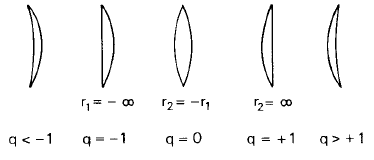
Refractors: Spherical aberration
 المؤلف:
A. Roy, D. Clarke
المؤلف:
A. Roy, D. Clarke
 المصدر:
Astronomy - Principles and Practice 4th ed
المصدر:
Astronomy - Principles and Practice 4th ed
 الجزء والصفحة:
p 254
الجزء والصفحة:
p 254
 19-8-2020
19-8-2020
 2325
2325
Refractors: Spherical aberration
The simple theory for lens design is based on the effects of refraction produced by spherical surfaces and this is particularly convenient as a spherical surface is one of the easiest to obtain on an optical grinding and polishing machine. However, simple lens theory only takes into account paraxial rays, i.e. rays that are very close to the optic axis, allowing sin θ to be written as θ. For a point source at infinity, lying on the axis of a single lens, the image produced by the lens does not retain a point-like appearance and is spread out into a disc. This effect results from the rays which cannot be considered as paraxial. The position of the focus for any incident ray depends on its distance from the optic axis.
The defect of the image is known as spherical aberration and its effect is illustrated . If the spread in focus is denoted by ΔF, the severity of any spherical aberration may be expressed by assessing the value of the ratio ΔF/F. As in the case of chromatic aberration, there is one plane through the spread of focus which contains the smallest image, again known as the circle of least confusion. Also the spread of an image along the optic axis is known as longitudinal spherical aberration and the spread of an image in the plane containing the circle of least confusion is known as lateral spherical aberration. The size of any image can be predicted by the physical properties of the lens or by performing a ray-tracing analysis.
The amount of spherical aberration depends on the shape of a lens. It is, therefore, convenient to define what is known as the shape factor of a lens. By denoting the radii of the two lens surfaces as r1 and r2, the shape factor, q, is expressed as
 (16.21)
(16.21)
Typical shapes of lenses have been drawn in figure 1 with a range of shape factors running between q < −1 and q > +1.
By examination of lenses over the complete range of shape factors, it is found that spherical aberration has minimal effect when q is close to +0·7—it never goes to zero. Spherical aberration can be overcome completely by figuring a lens so that the curvature of the faces is not constant. This process is known as aspherizing and is sometimes used in producing

Figure 1. A range of lenses with different shape factors.

Figure 2. Longitudinal spherical aberration for (a) a single lens and (b) a corrected doublet.
telescope objectives. However, this process can be costly and it is not the only way to remove spherical
aberration.
For a negative lens, the spherical aberration is also negative, i.e. the numerical value of the focal length increases as incident rays which are more distant from the optic axis are considered. A combination of a positive and a negative lens can be designed to provide a system which is free from spherical aberration. This is particularly convenient as we have already seen that chromatic aberration can be reduced by a two-lens system. Thus, achromatic lenses are designed to have minimal spherical aberration. The residual effect of spherical aberration for a corrected objective is illustrated in figure 2. In the same figure, the effect of spherical aberration of a single lens is drawn for contrast. If effects of chromatic and spherical aberration have not been removed completely, they may be noticeable when the primary image is viewed with an eyepiece. However, an eyepiece normally limits the field of view to a small angle and these may be the only defects of the image that will be detected.
By increasing the field of view, either by using a special wide-angle eyepiece or by placing a twodimensional imaging detector in the focal plane of the telescope, other types of aberration may become apparent. Such aberrations that might be detected in this way are: coma, astigmatism, field-curvature and field-distortion. Any of these aberrations may be present in images which result from incident rays which arrive at an angle to the optic axis. The effects and causes of each of these aberrations will now be discussed briefly.
 الاكثر قراءة في مواضيع عامة في علم الفلك
الاكثر قراءة في مواضيع عامة في علم الفلك
 اخر الاخبار
اخر الاخبار
اخبار العتبة العباسية المقدسة


